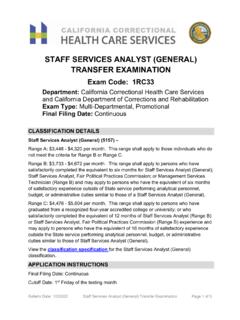Transcription of What Does a Business Analyst Do on an Agile Project?
1 11675 Rainwater Drive, Suite 325 Alpharetta GA 30009 Page 1 of 8We Get it. We ll Help You Get it Kent J. McDonAlDSenioR inStRuctoR, B2t tRAininGAs the use of Agile approaches increases, Business analysts struggle to determine how their role maps to the new approach and how it has changed from their familiar development process. Business analysts, for example, often find themselves proclaiming in everything I read/hear about Agile , I never see Business Analyst mentioned! Even though the role of Business Analyst is rarely mentioned in descriptions of Agile it does not mean that Business analysis does not occur. In fact, Agile s focus on delivering value to customers requires the entire team to collaboratively perform Business analysis on a frequent basis. This and other characteristics of Agile change how a Business Analyst works on a project . One change that Agile introduces is a barely sufficient process which does not prescribe any documentation, including requirements artifacts.
2 That does not mean that documentation is not produced, rather the Business Analyst collaborates with other team members to decide what is needed to best deliver the solution, including how much documentation is necessary. Contrast this with the detailed methodologies and standards for plan-driven projects used by large organizations that require Business analysts to complete extensive requirements documents. These artifacts lead Business analysts, especially less experienced ones, to document the same requirements several ways using different models and text even though more succinct recording of requirements is sufficient. Another change with Agile approaches is the use of short, time boxed delivery cycles referred to as iterations or sprints. These iterations include all the work necessary to go from a requirement to a running, tested feature that could be delivered to production.
3 The use of iterations allows the team to continuously reflect on their past efforts and adapt their processes to improve. The short timeframe of iterations (typically a week to a month) means that the scope for each iteration is much smaller than most traditional projects so the Business Analyst only needs to focus on the portion of the solution being delivered during that iteration. Business analysts collaborate with other team members to determine how much analysis is needed at the beginning of the project to establish the big picture, and during each iteration in order to establish a shared understanding without creating an extensive requirements inventory. A third change in Agile is the existence of the product owner role. The product owner is the ultimate decision maker and ultimate representative of Business needs for the project . In order to be truly effective, the person filling the product owner role should be well versed in many core Business analysis techniques, but they rarely are.
4 This provides the Business Analyst an excellent opportunity to assist the product owner as is discussed below. Finally, all team members have the opportunity to perform analysis so the Business Analyst also coaches the other team members on analysis techniques and the appropriate stakeholders to contact. Allowing multiple team members to perform analysis prevents handoffs that occur in phased based approaches, and What Does a Business Analyst Do on an Agile project ? 11675 Rainwater Drive, Suite 325 Alpharetta GA 30009 Page 2 of 8We Get it. We ll Help You Get it the Business analysts on the team from becoming bottlenecks to overall team activities that a Business Analyst performs to advise the product owner and coach the team, as well as other Business analysis considerations are discussed is Agile really about?There are as many different definitions of Agile as there are people providing definitions.
5 For the sake of this paper, Agile is defined as collaboration among stakeholders to deliver value to customers in frequent increments with consistent reflection and adaptation. This definition focuses on the characteristics that exist in all Agile environments, namely: Collaboration how the people involved in the effort work together which includes both the delivery team and project stakeholders Deliver value the true purpose of efforts is to provide value to customers, whether that is through new software, more efficient processes, or new products. Frequent increments the team delivers values every few days, weeks, or months rather than once at the end of a project Consistent reflection and adaptation the project team reflects on their approach and the product on a regular basis and adjusts approaches allow teams to focus on delivering the highest value as set by the Business in the shortest time.
6 Teams using Agile approaches self-organize to rapidly and repeatedly inspect actual working software in iterations ranging from one week to one month in duration. At the end of each iteration, anyone can see real working software and decide to release it as is or continue to enhance it for another biggest impact of iterations on Business analysts is the lack of an analysis phase. Instead of performing all analysis work to develop detailed requirements at the beginning of the project , Business analysis occurs throughout the project with an initial high level picture of the overall scope, followed by more detail on specific features when they are delivered. The key is knowing the sufficient amount of Business analysis necessary to understand the problem and the aspect of the solution currently being delivered and still keep the project moving forward. Another aspect of Agile approaches that impacts Business analysts is the lack of prescription.
7 Agile approaches are based on the premise that simple rules generate complex behavior so they provide a minimalist framework for teams to organize their work and leave the rest to the self-discipline of the team. So while Agile approaches do not require Agile RolesBecause of the focus on teamwork and collaboration, roles in Agile approaches are more general in nature than those of more plan based, or traditional prescriptive approaches. Tasks specific to the Business Analyst are not prescribed in an Agile environment, so Business analysis practitioners need to know where Business analysis techniques need to be applied in a are four primary roles included in an Agile Product Owner is the ultimate decision maker for the product. This role is responsible for defining the product vision, prioritizing features according to Business value, and answering team Scrum Master is the guardian of the team s process.
8 This role is responsible for ensuring the team has the appropriate environment to succeed, removing obstacles, and enabling close cooperation across all Team is a group of 5 9 people dedicated to the project full time who are responsible for self-organizing to deliver value to the customer in each iteration. The team determines how the product is developed, and how the work is divided up to do that based on the conditions at the time. A Stakeholder is anyone who can impact the project and provide input to the Business objectives of the product. Stakeholders actively involved in the project are part of the team. Stakeholders who are not actively involved in the project may still interact with the product owner to provide their input on the product backlog. 11675 Rainwater Drive, Suite 325 Alpharetta GA 30009 Page 3 of 8We Get it. We ll Help You Get it documentation, they do not prohibit any either.
9 Rather it is the appropriate amount of documentation. When teams are deciding what to document in an Agile project , Business analysts may suggest they ask the following questions: Is this something a stakeholder is requesting? Is this something the team needs in order to effectively do its job?Because the Business Analyst is not so focused on trying to document all requirements , rules, etc. for a separate development team, they can focus more time on actual analysis did we consider all the scenarios that may occur? Are we keeping our solution consistent? Do we know what unintended consequences we may be creating with this change?A final aspect of Agile that represents a departure from traditional approaches is the focus on teamwork over rigid specialization. The most noticeable result to Business analysts is that everyone on the team is encouraged to talk with stakeholders directly to understand their needs.
10 Business analysts may initially consider this a threat until they realize that they have an opportunity to coach their teammates how to be the most effective performing this activity, and they get to expand their toolkit by helping the other team members with their tasks. Agile teams don t always start out being completely collaborative. Teams will often initially fall in the trap of having developers only do development, testers only doing testing, and of course, analysts only doing analysis. Business Analysts help move the team toward a more collaborative nature by adopting the two roles that position them to be a truly value added member of the team: Business Advisor (supporting the Product Owner) Business Coach (Acting as the analysis expert on the team)The nature of the change in the Business analysts work is focused exclusively on how they interact with their team members, product owner, and stakeholders.










